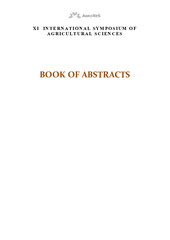Приказ основних података о документу
THE MOST IMPORTANT CROP MEASURES IN ORGANIC PRODUCTION OF WINTER WHEAT
| dc.creator | Dolijanović, Željko | |
| dc.creator | Simić, Milena | |
| dc.creator | Oljača, Snežana | |
| dc.creator | Dragičević, Vesna | |
| dc.creator | Gršić, Nemanja | |
| dc.creator | Jovović, Zoran | |
| dc.date.accessioned | 2023-12-15T12:12:45Z | |
| dc.date.available | 2023-12-15T12:12:45Z | |
| dc.date.issued | 2022 | |
| dc.identifier.isbn | 978-99938-93-81-3 | |
| dc.identifier.uri | http://aspace.agrif.bg.ac.rs/handle/123456789/6598 | |
| dc.description.abstract | Organic products of winter wheat are believed to be more nutritious and safer foods compared to the conventional alternatives by consumers, despite the higher price of these products. The experiment with organic technology of winter wheat was conducted at the research and study field "Radmilovac", Faculty of Agriculture Belgrade in 2016/17 and 2017/18 year on the luvic chernozem soil type. Organic cropping system included tillage with a disc harrow at 20 cm with the complete maize crop residues incorporation and the pre-sowing tillage with a harrow. The basic fertilization was conducted in autumn with 3.000 kg ha-1 biohumus (commercial name „Biohumus Royal offert“, producer „Altamed“ Serbia) and top dressing in spring with 5.0 l ha-1 biofertilizer („Slavol“, producer „Agrounik“ Serbia). The common (cv. 'NS 40S') and durum (cv. 'Dolap') winter wheat cultivars were used, both developed and adapted for organic growing system. It was important to underline that organic cropping system, after 17 years of experiment (from the beginning of the establishment of the organic four-field crop rotation until 2017/18) increased soil organic matter, due to the application of organic fertilizer in combination with other practices as a part of this system (application of bio-fertilizers, incorporation of crop residues, etc.). Statistical analysis confirmed that year and genotype have greater impact on wheat productivity than their interactions. More favorable meteorological conditions in the first year led to obtaining significantly higher grain yields (4.84 and 4.45 kg ha-1) and a greater 1000-grain weight (41.6 and 40.2 g). There were also significant differences in the productivity of the studied wheat cultivars. The grain yield of common soft wheat (4.34 kg ha-1) was significantly higher than that of durum wheat (3.050 kg ha-1). The inclusion of high yielding genotypes, with enhanced utilization efficiency into low-input technology based on careful choice of cultural practices, could be the important step in organic farming systems. | sr |
| dc.language.iso | en | sr |
| dc.publisher | University of Banja Luka Faculty of Agriculture Bulevar vojvode Petra Bojovića 1A 78000 Banja Luka Bosnia and Herzegovina | sr |
| dc.rights | openAccess | sr |
| dc.rights.uri | https://creativecommons.org/licenses/by/4.0/ | |
| dc.source | 11th International symposium on agricultural sciences and 27th conference of agricultural engineers of Republic of Srpska (Agrores 2022), 26-28, May, 2022, Trebinje, Bosnia and Herzegovina. Book of apstracts | sr |
| dc.subject | organic growing technology | sr |
| dc.subject | fertilizer | sr |
| dc.subject | cultivars | sr |
| dc.subject | grain yield | sr |
| dc.title | THE MOST IMPORTANT CROP MEASURES IN ORGANIC PRODUCTION OF WINTER WHEAT | sr |
| dc.type | conferenceObject | sr |
| dc.rights.license | BY | sr |
| dc.citation.epage | 79 | |
| dc.citation.spage | 78 | |
| dc.identifier.fulltext | http://aspace.agrif.bg.ac.rs/bitstream/id/25156/Book-of-Abstracts-AgroReS-2022-3.pdf | |
| dc.identifier.rcub | https://hdl.handle.net/21.15107/rcub_agrospace_6598 | |
| dc.type.version | publishedVersion | sr |


